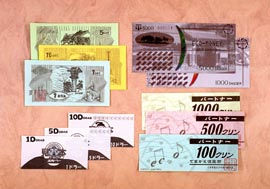|
 New
local currencies to promote community and environmental conservation
activities have begun circulating in several parts of Japan. While they
can't be used to buy things at supermarkets, you can offer them as "payment"
when someone provides you a service or earn them by helping someone
else. New
local currencies to promote community and environmental conservation
activities have begun circulating in several parts of Japan. While they
can't be used to buy things at supermarkets, you can offer them as "payment"
when someone provides you a service or earn them by helping someone
else.
In the town of Kuriyama, Hokkaido,
for instance, second grader Ami Hasegawa paid 1,000 kurins to get her
favorite toy fixed. The kurin is the local currency that was named after
the township.
Ami's father earned 3,000 kurins
for fixing the handrail of a staircase in a neighbor's house. And her
mother paid 1,000 kurins to an elderly man who wrote addresses for her
on postcards in beautiful handwiting.
The Hasegawas were among 260 participants
in the town's "eco-money" project. The local government allotted each
of them 20,000 kurins in three different denominations of 100, 500,
and 1,000 kurins.
There are more than 200 items on
the list of services that can be purchased with the currency, such as
removing snow from the roof, looking after the house during a long absence,
and reading picture books to kids.
Ami circled two items she's willing
to do: taking dogs out for a walk and accompanying someone when going
shopping. She's eagerly looking forward to getting a request for help
so she can earn more kurins.
Ami's mother Mayumi claims she's
gotten to know her neighbors better since joining the eco-money program.
"With kurins," she points out, "it's a lot easier to ask for help with
small things."
In spring 1999 Kusatsu in Shiga
Prefecture became the first city in Japan to use eco-money, calling
it the ohmi, which is what the prefecture was called in the old days.
Several other cities followed suit with currencies of their own, with
Matsue, Shimane Prefecture, calling it the dagger (borrowed from the
local dialect) and Takaoka, Toyama Prefecture, naming it the dorar (for
the cartoon character Doraemon,
whose creator hails from the city).
Some 30 more communities across
Japan are now preparing to introduce such currencies, according to the
Eco-Money Network, set up in May 1999. Some municipalities plan to use
the money to plant trees and reduce garbage.
Claims Eco-Money Network Secretary
General Masanari Nakayama, "Eco-money is a way of getting neighbors
to help each other out and to deepen their ties to the community."
Photo: Some of the "eco-money" that is now
used in parts of Japan. (Asahi Shogakusei Shimbun)
|

